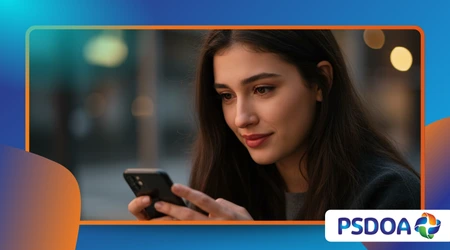Parasocial Relationships: Falling for Someone Who Doesn’t Know You Exist

Parasocial relationships captivate us, weaving emotional bonds with figures who remain blissfully unaware of our existence.
Anúncios
In 2025, these one-sided connections thrive, fueled by social media’s intimacy and AI’s uncanny ability to mimic friendship.
From YouTube vloggers to AI chatbots, these relationships shape how we connect, offering comfort but also risks. Why do we invest so deeply in someone who can’t reciprocate?
This article dives into the psychology, cultural shifts, and ethical dilemmas of parasocial relationships, exploring their allure and impact.
We’ll uncover their benefits, pitfalls, and how to navigate them thoughtfully in today’s hyper-digital world.
Anúncios
The phenomenon isn’t new fans have long adored distant celebrities but technology has intensified it. Social media platforms like Instagram and TikTok create illusions of closeness through curated glimpses into creators’ lives.
AI avatars, like those on Snapchat, respond with startling warmth, blurring lines between simulation and reality. This exploration argues that while parasocial relationships can foster belonging, they demand balance to avoid emotional dependency.
Let’s unravel this intricate dance of human connection in the digital age, grounded in real-world insights and psychological truths.
The Psychology Behind Parasocial Relationships
Horton and Wohl coined the term parasocial relationships in 1956, describing one-sided bonds with media figures. These connections mimic real friendships but lack mutuality.
Our brains crave social bonds, so we project emotions onto influencers or characters. Dopamine surges when a favorite streamer “notices” us, simulating real connection.
This illusion thrives on repeated exposure daily vlogs or posts create familiarity. Yet, the bond remains one-way, leaving us vulnerable to unreciprocated attachment.
The brain’s reward system doesn’t distinguish between real and virtual interactions well. A 2023 study from UCLA found 62% of Gen Z felt emotionally attached to influencers.
This statistic highlights how parasocial relationships tap into our need for belonging. We craft narratives about these figures, filling gaps with idealized traits.
++ The Rise of “Main Character Syndrome” on Social Media
For example, Emma, a 24-year-old from Chicago, feels her favorite YouTuber “gets” her struggles, despite never meeting. This projection can comfort but risks overshadowing real-world ties.
Our need for connection drives these bonds, especially in isolating times. Social media’s design likes, comments, and personalized algorithms amplifies this.
When an influencer responds to a comment, it feels personal, yet it’s often algorithmic. These interactions spark joy but can foster dependency.
Understanding this psychology helps us appreciate their power and limits, urging mindful engagement with digital “friends.”

The Role of Social Media and AI in Amplifying Parasocial Bonds
Social media platforms engineer intimacy, making parasocial relationships feel reciprocal. Instagram Stories or TikTok lives offer glimpses into creators’ lives, fostering perceived closeness.
Algorithms prioritize content we engage with, deepening emotional investment. A creator’s “good morning” video feels like a personal greeting, though it’s broadcast to millions. This curated vulnerability builds trust, but it’s a performance, not a friendship.
AI takes this further, creating hyper-realistic interactions. Snapchat’s AI avatars, for instance, recall past chats and mimic empathy. Unlike influencers, AI responds directly, tailored to our inputs.
This interactivity blurs reality, as users like Jake, a 19-year-old gamer, treat AI as a confidant. Yet, AI lacks genuine emotion, raising ethical questions about simulated companionship. These tools amplify connection but risk distorting our sense of reality.
Also read: Digital Dopamine: How Apps Hijack the Reward System
The platform effect isn’t accidental features like subscriptions or livestreams monetize emotional bonds. Creators benefit from engagement, but fans may feel exploited.
Balancing authenticity with algorithmic demands is tricky. While social media and AI enhance connection, they also commodify it, urging us to question what’s genuine in these digital embraces.
The Benefits of Parasocial Relationships
Parasocial relationships offer emotional solace, especially for the lonely. They provide safe spaces to explore identity without judgment.
Teens, for instance, might emulate an influencer’s style, testing self-expression. Online fan communities, like those on Discord, foster belonging through shared admiration. These bonds can reduce stress, offering a low-risk emotional outlet.
For marginalized groups, these connections are vital. Virtual spaces allow visibility and community without rejection risks.
A transgender teen might find solace in a YouTuber’s coming-out story, feeling seen. These relationships can inspire, as fans adopt creators’ values or activism. They act like a warm blanket, comforting without demanding vulnerability in return.
Read more: Why the Brain Loves Conspiracy Theories
Research supports this: a 2024 study from the Journal of Social Psychology noted parasocial bonds reduced loneliness in 58% of participants.
They’re a lifeline when real-world connections falter. However, their value lies in complementing, not replacing, mutual relationships. Recognizing their role helps us harness their benefits while staying grounded.
The Risks and Ethical Dilemmas
Despite their appeal, parasocial relationships can become crutches. Over-reliance risks isolating us from reciprocal bonds. Fans may prioritize a streamer over friends, mistaking one-sided intimacy for mutual care.
When creators like Charli D’Amelio take breaks, fans experience “parasocial breakups,” feeling genuine grief. This emotional toll reveals the depth of these attachments.
Ethically, creators face a tightrope. Monetizing engagement through sponsorships or subscriptions can blur authenticity. Fans may feel betrayed when a “friend” pushes products.
Creators like Morgan Chen emphasize collective gratitude over individual promises, avoiding false intimacy. Yet, platforms incentivize emotional manipulation, complicating ethical boundaries.
| Aspect | Benefit | Risk |
|---|---|---|
| Emotional Support | Reduces loneliness, offers inspiration | Dependency, neglect of real relationships |
| Community | Fosters belonging in fan groups | Parasocial breakups, emotional grief |
| Creator Influence | Models positive behaviors | Potential for manipulation or exploitation |
AI companions raise further concerns. Their constant availability can make human relationships seem lacking. Over-dependence may lead to derealization, where reality feels less vivid.
Creators and platforms must prioritize transparency to prevent harm, ensuring fans understand the one-sided nature of these bonds.
Navigating Parasocial Relationships in 2025
Awareness is key to healthy parasocial relationships. Recognize their one-sided nature to avoid over-investment. Set boundaries, like limiting screen time, to prioritize real-world ties.
For example, Sarah, a 30-year-old teacher, caps her TikTok scrolling to nurture friendships. Engaging in fan communities, not just creator worship, fosters mutual connection.
Creators can help by setting clear expectations. Transparent statements, like “I can’t reply to everyone,” clarify boundaries.
Encouraging peer-to-peer interaction, such as Discord groups, shifts focus from creator to community. This balance preserves the joy of fandom while grounding users in reality.
Reflect on your emotional investment. Ask yourself: Are these digital bonds enhancing or replacing my real connections? Regular self-checks prevent over-reliance.
By blending digital inspiration with tangible relationships, we can enjoy parasocial connections without losing sight of what’s real.
The Future of Parasocial Relationships

As technology evolves, parasocial relationships will deepen. Virtual reality could make interactions feel more lifelike, blurring boundaries further.
Imagine “chatting” with a VR influencer who feels present exciting, yet risky. AI advancements might create companions that anticipate our needs, challenging our understanding of connection.
Ethical frameworks must evolve too. Platforms should prioritize user well-being over engagement metrics. Creators might adopt codes of conduct, emphasizing authenticity over profit.
Fans will need digital literacy to navigate these bonds, recognizing simulations for what they are. The future promises richer connections, but only if we approach them mindfully.
Consider the analogy of a favorite book: we love its characters, but we know they’re fictional. Similarly, parasocial bonds can inspire without consuming us.
As we move into 2026, fostering awareness will ensure these relationships remain a source of joy, not dependency, in an increasingly connected world.
Conclusion
Parasocial relationships weave a complex tapestry of connection in 2025, blending comfort with caution. They offer solace, inspiration, and community, especially for those craving belonging.
Yet, their one-sided nature demands vigilance to avoid emotional pitfalls. By understanding their psychology, leveraging their benefits, and setting boundaries, we can embrace these bonds without losing ourselves.
Creators and platforms bear responsibility to foster authenticity, ensuring these connections uplift rather than exploit.
As technology reshapes intimacy, let’s cherish the warmth of parasocial bonds while rooting ourselves in the messiness of real human connection. What will you choose digital comfort or the unpredictable beauty of mutual care?
FAQs
1. What are parasocial relationships?
They’re one-sided emotional bonds with media figures or AI who don’t know you, like feeling close to an influencer.
2. Are parasocial relationships harmful?
Not inherently they can reduce loneliness but over-reliance may neglect real-world connections or cause emotional dependency.
3. How can I manage parasocial relationships?
Set screen time limits, engage in fan communities, and prioritize mutual relationships to maintain balance.
4. How do creators handle parasocial dynamics?
Ethical creators set clear boundaries, encourage community interaction, and avoid promising individual relationships they can’t fulfill.
